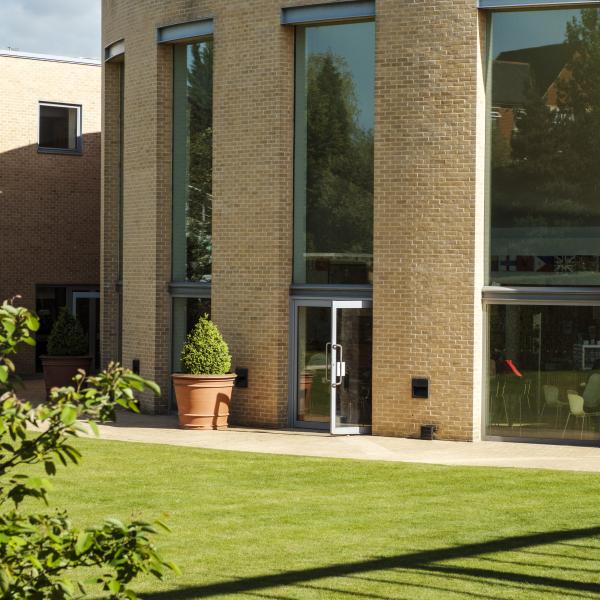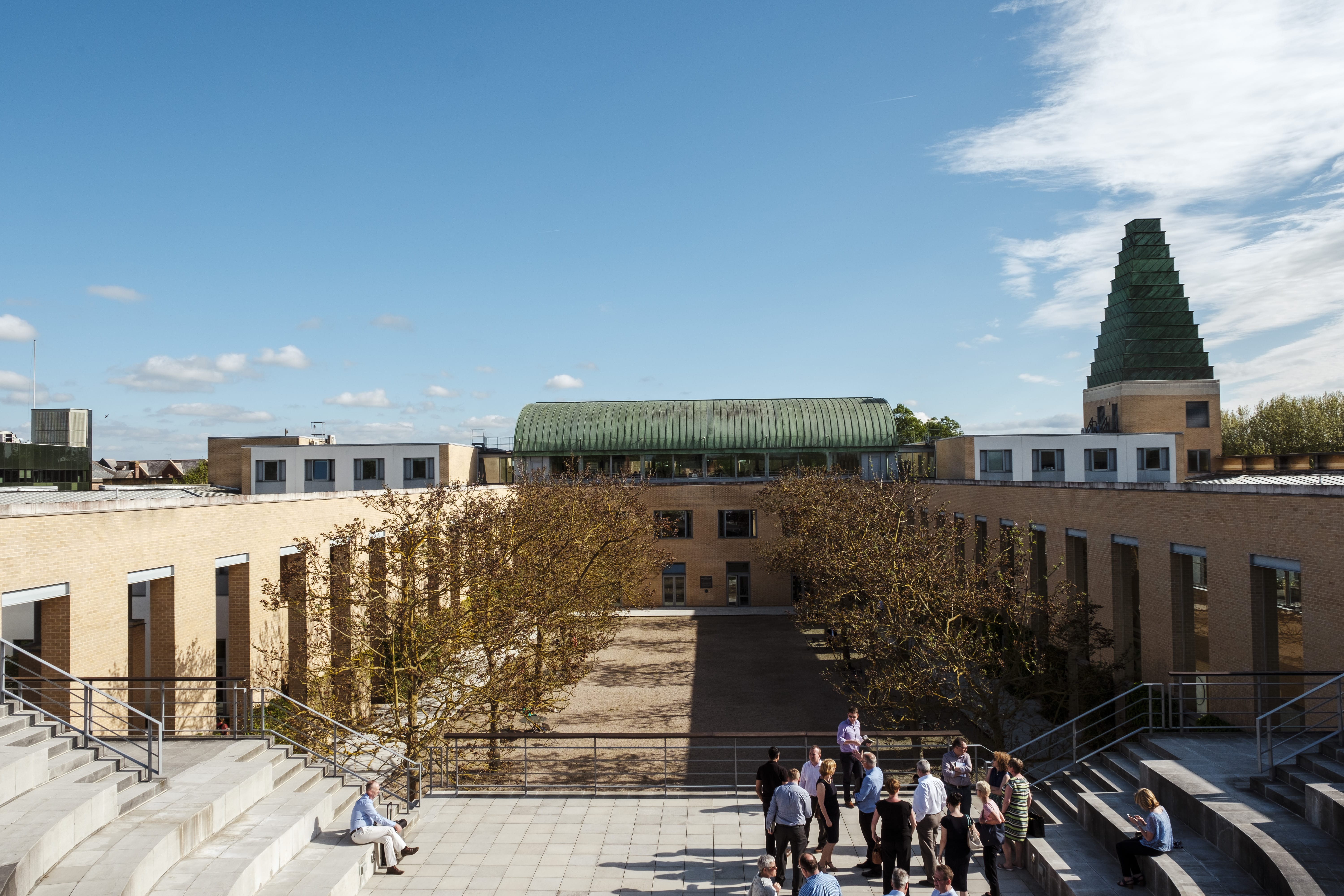Alix Zwane, CEO of the Global Innovation Fund, spoke at the School's Distinguished Speaker Seminar.
She discussed how alleviating poverty and reducing fragility requires a pro-development, market-based approach.
In 2017, Zwane visited a rural school in Northern Ghana where an organisation called Lively Minds is delivering a community volunteer programme. Although Ghana has universal pre-school provision, the teacher:student ratios are usually around 45:1. This programme brings in mothers to look after Montessori-style work stations, allowing children to experience a ratio of around 5:1 or 6:1. The results include reduced teacher absenteeism, improved cognition patterns for children, and the empowerment of the local, often illiterate women who are engaged in volunteering.
A few days later, in Accra, Zwane came across ‘The Impact Hub,’ an incubator and co-working space full of entrepreneurs who are ‘dreaming big, and thinking about building markets, not just selling into them.’
‘It’s an hour’s plane ride from one of those worlds to the other,’ she said, ‘and that’s increasingly what the experience of international development is like. Poor, marginalised people like the volunteers that Lively Minds work with are also potential customers of skilled entrepreneurs who come from the same local context that they do ... So we have to think differently, those of who are engaged in the business of aid.’
Zwane pointed out that neither Lively Minds nor the Impact Hub is the type of organisation to attract aid funding. But nor are they targets for traditional capital: as young firms the financial returns they may deliver will come over a much longer term than most investors can work with.
So, she said, ‘I want to talk about a case for a different approach, a complementary approach to development finance, to help us to think about how to address this new world in which Lively Minds and the Impact Hub in Accra exist in very close proximity to each other.’
Fragile places
Over the past 200 years, the percentage of the world’s population living in extreme poverty has dropped dramatically. Literacy rates have increased: two hundred years ago only the elite 12 per cent had the ability to read. Today those numbers are flipped and it’s 12 per cent or so who do not.
‘Where poverty does exist, where deprivation does exist, it’s increasingly found in fragile places, said Zwane. The definition of fragility included post-conflict and conflict settings, but also covered places that struggle with institutional capacity and other economic and governance challenges that leave them vulnerable to shocks:
It is difficult to make such places attractive to private capital from outside, while local private capital is likely to be weak and shallow. What are the appropriate types of development finance to accelerate economic growth and help pull themselves out of the cycle of crisis and poverty?
Aid
Zwane was clear that official government aid remains a key part of the solution for helping people living in fragile places: ‘Aid has been absolutely vital in responding to humanitarian disasters, disease outbreaks, providing global public goods and improving health and security for poor people, particularly where markets don’t work.’
Diaspora
Remittances from diaspora populations are often discounted, but they can play an important part in supporting entrepreneurs and entrepreneurship. However, they cannot necessarily follow firms past the friends-and-family stage, when you begin to need relatively larger amounts of capital as you grow your business.
Development finance institutions
DFIs take public money and invest in companies. Like private equity firms, they don’t want any investment to lose money. Everything should make a little bit of money – unlike a venture capital portfolio, in which as long as you have one home run, you don’t mind if nine out of ten investments fail.
‘The challenge for the DFIs has been the D,’ said Zwane. ‘The shareholders of these institutions regularly challenge them to demonstrate that the work that they’re doing helps the poor and contributes to inclusive work.’
Bridging the pioneer gap
Entrepreneurs behind innovative ventures may be able to scrape together resources from their own savings, from their friends and their families, and from challenge funds that many missions of aid agencies run. They can get as far as understanding the market need, developing a value proposition, and demonstrating proof of concept. But, as Zwane reminded us, you need lots of rounds of funding before you get to a scalable model – and certainly before you’re able to access local commercial finance.
‘That gap can really turn into a chasm for entrepreneurs that are trying to build the markets that they’re selling into,’ she said. This is particularly wide in fragile places where there are high levels of country risk and other approaches to financing innovation are limited.
Venture philanthropy
Zwane felt that the key was exploiting the space in the middle of the ‘returns continuum’, which has aid money (expecting 100% loss) at one end and DFIs (expecting a profit) at the other.
‘The Global Innovation Fund is backed almost exclusively by bilateral aid agencies,’ she explained. ‘We are a registered charity in the UK for tax efficiency purposes, but we do grant, debt and equity investing out of an evergreen funding structure. We’re unique in that our governance structure, our regulatory structure, allows us to take bilateral money, that risk averse money – whether it’s risk averse because it’s coming out of a bilateral agency or it’s risk averse because it’s got to deliver private equity style returns – and turn it into money that can take smart venture style risks, that can create a portfolio, that if we’re doing it right looks more like a venture capitalist portfolio. And we are highly motivated, directed to focus our attention on generating impact for people who live under $5 per day.’
She gave one example of how GIF was able to support a Nigerian company that provides services to improve the livelihoods of smallholder farmers.
The owner, Cola, had managed to raise some early stage capital from a small family foundation in the bay area, in California, and from an institution in Nigeria. But once his business was up and running he really needed flexible capital in order to provide credit to farmers. International commercial capital, including DFIs, wanted to make loans denominated in dollars – because there was a currency risk associated with working in Nigeria – but that of course exposed Cola to risk too. GIF agreed to be a subordinate debt funder, giving the company debt denominated in the local currency in Nigeria, co-ordinated and alongside with senior debt denominated in dollars for other investors including DFIs.
GIF could do that because its mission and mandate is to put social value first. ‘Once you take that currency devaluation into account, we’re probably going to lose some money,’ admitted Zwane, ‘but we’re not losing 100 per cent. This is not a grant. But we believe that the small amount of concessionality that’s implicit in our world is well outweighed by the social impact that we can generate.’
‘And this is not an isolated story. This is the story of many entrepreneurs in fragile places, and doing venture capital style funding for folks like this means that we can make more investments that are scalable and have substantial social impact.’
Challenges
Zwane admitted that there is a risk with using taxpayer money to catalyse private investment. Mixing public and private money together can distort markets, and can crowd out private finance. It can pick winners inappropriately and can squander resources that might have been better spent on global public goods, basic infrastructure. However, she believes that following some key principles can mitigate some of those risks:
- Target investments where social returns exceed financial returns
- Think carefully about how much concessionality you’re willing to give away
- Measure social value
She concluded by hoping for ‘an eco-system of funders who are distributed all along the returns continuum with different kinds of money… if we can do this right, it will be a critical new complementary tool for thinking about how to help those poor people in pockets of fragility.’

